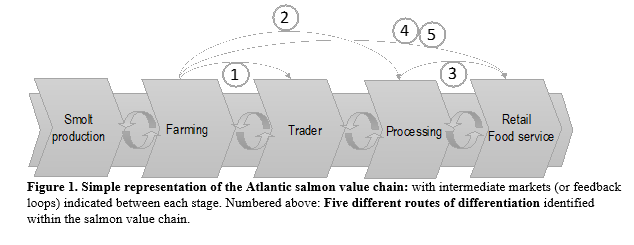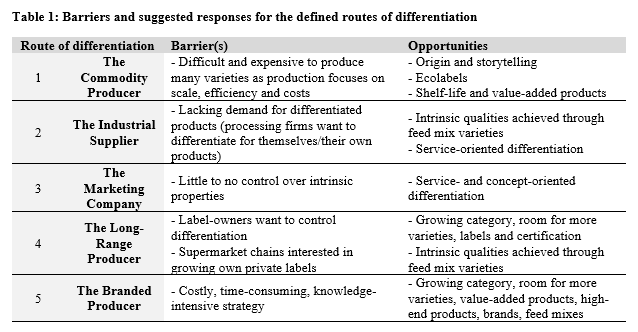DIFFERENTIATION AND INNOVATION IN NORWEGIAN SALMON AQUACULTURE: BARRIERS AND OPPORTUNITIES
Introduction
The level of control over the farming process in salmon aquaculture makes it possible , in principle, for farmed Atlantic salmon to be tailored on a number of dimensions to meet requirements from different customer groups at different stages of the value chain. However, production, harvesting and primary processing of salmon have resulted in largely homogeneous product s being exported from Norway. A round 85% of Norwegian salmon is exported as whole, gutted salmon (Norwegian Seafood Council, 2019). Primary processing in Norway focuses on fresh whole salmon with few of the farming companies also selling processed salmon, mostly as fresh or frozen fillets, and a few making portions and “ready-to-eat” products. As so much of the salmon is sold whole, and with fillets being of very similar quality, products can mainly be considered commodities, with standardized specifications and sold in markets where the price is driven by supply and demand (Asche , Bremnes, and Wessells , 1999; Asche and Bjørndal, 2011). Innovation tends to be focused on efficiency, and less on product development. Differentiated products are thus relatively few and associated volumes are small (Asche , Cojocaru, and Roth, 2018).
discuss to what extent salmon is differentiated, how the differentiation strategies answer customers’ quality demands, and the degree to which various attributes offer competitive benefits, leading to advantages or price premiums. However, while having identified general barriers to differentiation, we also found that differentiation is understood and approached differently across industry players depending on where in the value chain they operate or what customers they are serving.
This paper identifies five major routes of differentiation for salmon , including the strategies for differentiation as understood from the points in the supply chain where they are executed today. The paper then discusses specific barriers for each route of differentiation, including opportunities for achieving differentiation in each of them. To obtain information with respect to differentiation strategies for salmon, we conducted in-person interviews with a range of Norwegian producers, the majority of them also operating internationally.
Results
“It´s not the Norwegians who have done a good job, it´s all the customers.” This quote from one of our informants illustrates the fact that differentiation of salmon products has taken place at different stages in the value chain, and not with the producers themselves. It implies different relations between sellers and buyers, with varying power balance and opportunities for differentiation. The value chain for Atlantic salmon, sketched in Figure 1, resembles that of other (intensive) food production systems such as pork and poultry (Asche , 2008; Asche , Cojocaru, and Roth, 2018), There is also an increasing tendency towards vertical integration (Kvaløy and Tveterås , 2008; Asche et al., 2013), with producers responsible for all stages from smolt production to export, but with little to no activities past the stage of primary processing.
The identification of differentiation routes throughout the value chain allowed for a classification of the differentiation strategies used. Figure 1 shows the five main routes of differentiation identified based on the interviews we conducted.
The first we termed 1) The commodity producer , as most Norwegian salmon producers are large-scale producers of highly perishable products, implying a focus on low production costs and efficient production and logistics, with little differentiation. Slightly more differentiated products are sold by the 2) The industrial supplier , supplying process ors closer to the destination market, either in low-cost countries like Poland, or in the destination country. Processors, that either have their own brand or cater to private labels for retail chains, rarely ask for differentiated products, as they do their own differentiation, but choose suppliers based on industrial relations , where quality as supplier is as prominent as quality of products . 3) The marketing company . Some traders make an effort to move away from trading the salmon as a commodity, towards marketing the salmon as something more distinctive. They move from sales to marketing. 4) The long-range producer typically works with retail chains, contributing to a greater range and variety of products, which might be sold both under the producer´s own label or the chain´s label. 5) The branded producer. A few of the largest salmon producers have launched their own brands, but only one has set off to create a global one. Brands are most prominent in the home market, or markets close to Norway, but are also slowly spreading to some of the major markets.
The routes identified above place an array of requirements on the firms, require different resources, or the firm’s position in the value chain may lead to different probabilities of success. In practice, these differentiation route archetypes can vary from firm to firm. Some companies may also choose to pursue a number of routes in parallel, depending on the customer segments they serve. While
identified general barriers for differentiation, this paper points to barriers for each of the identified routes of differentiation, and identifies responses to overcome these barriers.
The paper also discusses to what degree this categorization will be stable over time. Recent developments in new production techniques, with widespread innovation in new production processes ( land-based farming, closed or semi-closed containment at sea, off-shore aquaculture, etc), might increase the focus on differentiation, and the share of production being marketed as differentiated products , as marketing of benefits with new production technologies, aiming to obtain premium prices, is meant to offset cost disadvantages and high investment cost in new concepts.

